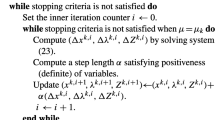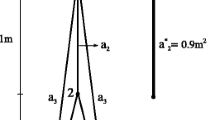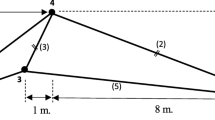Abstract
Kinematic stability is an often overlooked, but crucial, aspect when mathematical optimization models are developed for truss topology design and sizing optimization (TTDSO) problems. In this paper, we propose a novel mixed integer linear optimization (MILO) model for the TTDSO problem with discrete cross-sectional areas and Euler buckling constraints. Random perturbations of external forces are used to obtain kinematically stable structures. We prove that, by considering appropriate perturbed external forces, the resulting structure is kinematically stable with probability one. Furthermore, we show that necessary conditions for kinematic stability can be used to speed up the solution of discrete TTDSO problems. Using the proposed TTDSO model, the MILO solver provides optimal or near optimal solutions for trusses with up to 990 bars.






Similar content being viewed by others
References
Aage N, Andreassen E, Lazarov B S, Sigmund O (October 2017) Giga-voxel computational morphogenesis for structural design. Nature 550(7674):84–86. https://doi.org/10.1038/nature23911
Achtziger W, Kočvara M (2007) On the maximization of the fundamental eigenvalue in topology optimization. Struct Multidiscip Optim 34(3):181–195. https://doi.org/10.1007/s00158-007-0117-3
Arora JS, Wang Q (2005) Review of formulations for structural and mechanical system optimization. Struct Multidiscip Optim 30(4):251–272
Ben-Tal A, Bendsøe M P (1993) A new method for optimal truss topology design. SIAM J Optim 3(2):322–358
Bendsøe M P (1989) Optimal shape design as a material distribution problem. Structural Optimization 1(4):193–202
Bendsøe M P, Ben-Tal A, Zowe J (1994) Optimization methods for truss geometry and topology design. Structural Optimization 7(3):141–159
Bons N P, Martins J R R A (2020) Aerostructural wing design exploration with multidisciplinary design optimization. In: AIAA Scitech 2020 Forum, Orlando, Florida, 6-10 January
Brooks T R, Kenway G K W, Martins J R R A (2017) Undeflected common research model (uCRM): an aerostructural model for the study of flexible transonic aircraft wings. In: 35th AIAA Applied Aerodynamics Conference, AIAA paper 2017-4456, Denver, Colorado, 5-9 June
Chauhan S S, Martins J R R A (2018) Low-fidelity aerostructural optimization of aircraft wings with a simplified wingbox model using OpenAeroStruct. In: Proceedings of the 6th International Conference on Engineering Optimization, EngOpt 2018. Springer, Lisbon, Portugal, pp 418–431
Dorn W S, Gomory R E, Greenberg H J (1964) Automatic design of optimal structures. Journal de Mecanique 3:25–52
Faustino A M, Júdice J J, Ribeiro I M, Neves A S (2006) An integer programming model for truss topology optimization. Investigação Operacional 26(1):11–127
Gally T, Pfetsch M E, Ulbrich S (2018) A framework for solving mixed-integer semidefinite programs. Optimization Methods and Software 33(3):594–632. https://doi.org/10.1080/10556788.2017.1322081
Ghosh A, Mallik A K (2002) Theory of mechanisms and machines. Affiliated East-West Press Private Limited
Gurobi Optimization Inc. (2019) Gurobi optimizer reference manual. http://www.gurobi.com
Haftka R T, Gürdal Z (2012) Elements of structural optimization. Springer Science & Business Media
Hajela P, Lin C Y (1992) Genetic search strategies in multicriterion optimal design. Structural Optimization 4(2):99–107. https://doi.org/10.1007/BF01759923
Hashimoto D, Kanno Y (2015) A semidefinite programming approach to robust truss topology optimization under uncertainty in locations of nodes. Struct Multidiscip Optim 51(2):439–461. https://doi.org/10.1007/s00158-014-1146-3
Jasa J P, Hwang J T, Martins J R R A (2018) Open-source coupled aerostructural optimization using Python. Struct Multidiscip Optim 57(4):1815–1827. https://doi.org/10.1007/s00158-018-1912-8
Kanno Y (2016) Global optimization of trusses with constraints on number of different cross-sections: a mixed-integer second-order cone programming approach. Comput Optim Appl 63(1):203–236
Kanno Y (2018) Robust truss topology optimization via semidefinite programming with complementarity constraints: a difference-of-convex programming approach. Comput Optim Appl 71(2):403–433
Kanno Y, Fujita S (2018) Alternating direction method of multipliers for truss topology optimization with limited number of nodes: a cardinality-constrained second-order cone programming approach. Optim Eng 19(2):327–358
Kanno Y, Guo X (2010) A mixed integer programming for robust truss topology optimization with stress constraints. Int J Numer Methods Eng 83(13):1675–1699
Kennedy G J (2016) A full-space barrier method for stress-constrained discrete material design optimization. Struct Multidiscip Optim 54(3):619–639. https://doi.org/10.1007/s00158-016-1428-z
Kennedy G J, Martins J R R A (2014) A parallel aerostructural optimization framework for aircraft design studies. Struct Multidiscip Optim 50(6):1079–1101
Mela K (2014) Resolving issues with member buckling in truss topology optimization using a mixed variable approach. Struct Multidiscip Optim 50(6):1037–1049. https://doi.org/10.1007/s00158-014-1095-x
Ohsaki M, Katoh N (2005) Topology optimization of trusses with stress and local constraints on nodal stability and member intersection. Struct Multidiscip Optim 29(3):190–197. https://doi.org/10.1007/s00158-004-0480-2
Rajasekaran S, Sankarasubramanian G (2001) Computational structural mechanics, PHI Learning Pvt.
Rozvany G I N (1996) Difficulties in truss topology optimization with stress, local buckling and system stability constraints. Structural Optimization 11(3):213–217. https://doi.org/10.1007/BF01197036
Rozvany George IN (2009) A critical review of established methods of structural topology optimization. Struct Multidiscip Optim 37(3):217–237
Shahabsafa M, Mohammad-Nezhad A, Terlaky T, Zuluaga L, He S, Hwang J T, Martins Joaquim RRA (2018) A novel approach to discrete truss design problems using mixed integer neighborhood search. Struct Multidiscip Optim 58(6):2411–2429
Sokół T (2011) A 99 line code for discretized michell truss optimization written in mathematica. Struct Multidiscip Optim 43(2):181–190
Stolpe M (2004) Global optimization of minimum weight truss topology problems with stress, displacement, and local buckling constraints using branch-and-bound. Int J Numer Methods Eng 61(8):1270–1309. https://doi.org/10.1002/nme.1112
Stolpe M (2007) On the reformulation of topology optimization problems as linear or convex quadratic mixed 0–1 programs. Optim Eng 8(2):163–192. https://doi.org/10.1007/s11081-007-9005-3
Stolpe M, Svanberg K (2004) A stress-constrained truss-topology and material-selection problem that can be solved by linear programming. Struct Multidiscip Optim 27(1):126–129. https://doi.org/10.1007/s00158-003-0364-x
Stolpe M (2015) Truss topology optimization with discrete design variables by outer approximation. J Glob Optim 61(1):139–163
Stolpe M (2016) Truss optimization with discrete design variables: a critical review. Struct Multidiscip Optim 53(2):349–374. https://doi.org/10.1007/s00158-015-1333-x
Sved G, Ginos Z (1968) Structural optimization under multiple loading. Int J Mech Sci 10(10):803–805. https://doi.org/10.1016/0020-7403(68)90021-0. http://www.sciencedirect.com/science/article/pii/0020740368900210
Van Mellaert R, Lombaert G, Schevenels M (2015) Global size optimization of statically determinate trusses considering displacement, member, and joint constraints. J Struct Eng 142(2):04015120
Zegard T, Paulino G H (2014) GRAND – ground structure based topology optimization for arbitrary 2D domains using MATLAB. Struct Multidiscip Optim 50(5):861–882
Zegard T, Paulino G H (2015) GRAND3 – ground structure based topology optimization for arbitrary 3D domains using MATLAB. Struct Multidiscip Optim 52(6):1161–1184
Zhou M, Rozvany GIN (1991) The COC algorithm, part II: topological, geometrical and generalized shape optimization. Comput Methods Appl Mech Eng 89(1):309–336. https://doi.org/10.1016/0045-7825(91)90046-9. http://www.sciencedirect.com/science/article/pii/0045782591900469
Zienkiewicz O C, Taylor R L (2005) The finite element method for solid and structural mechanics, Elsevier
Acknowledgments
This research was supported by Air Force Office of Scientific Research Grant no. FA9550-15-1-0222. The authors would like to thank the editors and the referees to provide constructive suggestions which allowed us to improve the article significantly.
Author information
Authors and Affiliations
Corresponding author
Ethics declarations
Conflict of interest
The authors declare that they have no conflict of interest.
Additional information
Responsible Editor: Fred van Keulen
Replication of results
The data of the Michell trusses that are solved in this study are made publicly available in the GitHub repository: https://github.com/shahabsafa/truss-data.git. The repository, for each test problem, includes both the raw data of the structure and the MPS file used as input for the Gurobi solver.
In the computational experiments, we used the commercial, state-of-the-art, mixed integer linear optimization software Gurobi (2019) to solve all test problems. The specification of the workstation used, and the specific parameter settings of Gurobi ver. 9.0.0 solver are presented on p. 10, at the beginning of Section 5.
Publisher’s note
Springer Nature remains neutral with regard to jurisdictional claims in published maps and institutional affiliations.
Appendices
Appendix 1
In the basic discrete model, the choice constraints for the TTDSO problem are defined as:
To enforce equalities (8) and (9), the following set of constraints is needed:
The Euler buckling constraints are incorporated in the set of constraints (27) as well. The basic MILO model for TTDSO is defined as:
If yi = 1, for \(i\in \mathcal {I}\), then the problem reduces to a truss sizing optimization problem. In a truss sizing optimization problem, bar-crossing elimination and bar-overlapping elimination constraints are not needed, since the topology of the structure is pre-determined by the ground structure.
Appendix 2
The list of the definitions of the article is given in Table 6.
The decision variables of the mathematical model and the parameters introduced in the article are presented in Tables 7 and 8, respectively.x
Rights and permissions
About this article
Cite this article
Shahabsafa, M., Fakhimi, R., Lei, W. et al. Truss topology design and sizing optimization with guaranteed kinematic stability. Struct Multidisc Optim 63, 21–38 (2021). https://doi.org/10.1007/s00158-020-02698-x
Received:
Revised:
Accepted:
Published:
Issue Date:
DOI: https://doi.org/10.1007/s00158-020-02698-x




